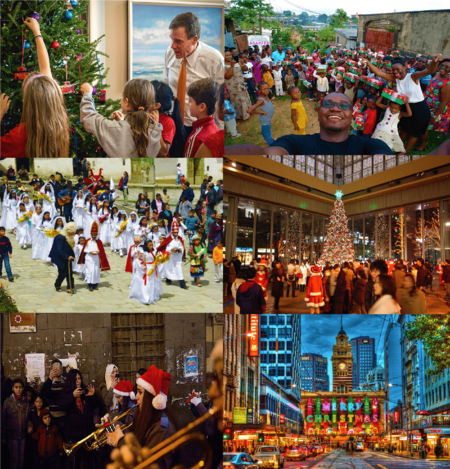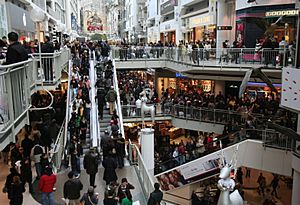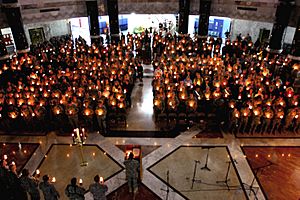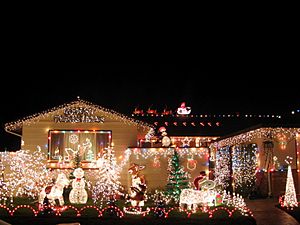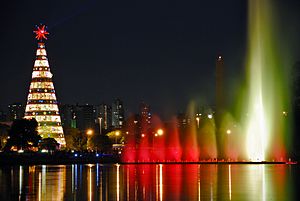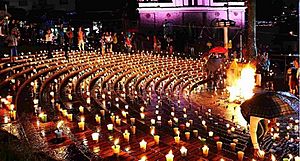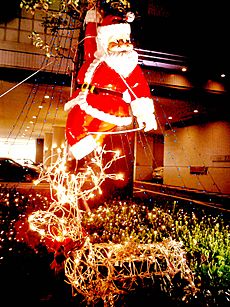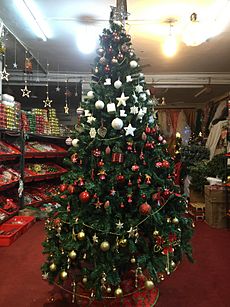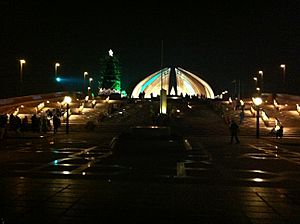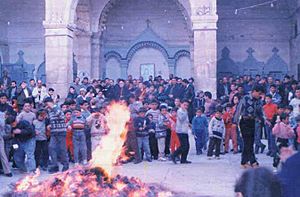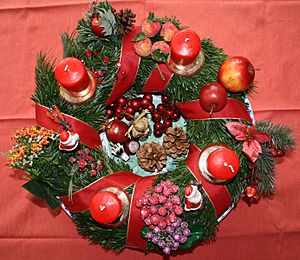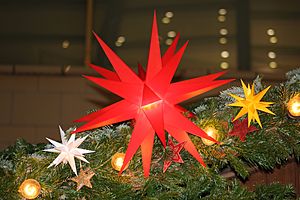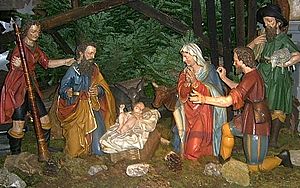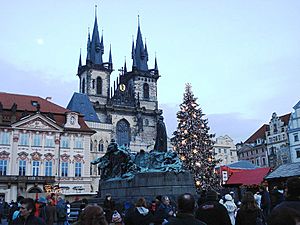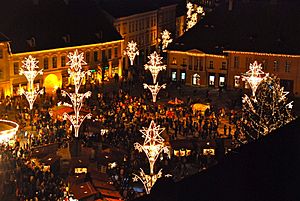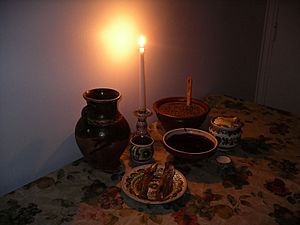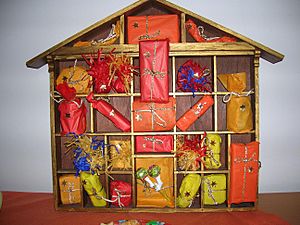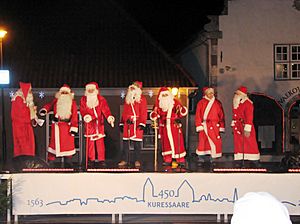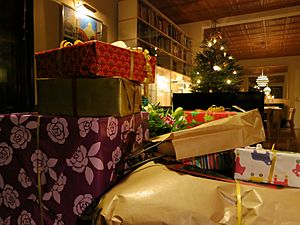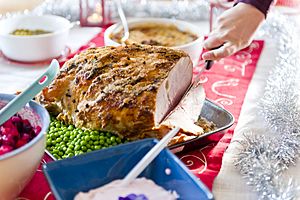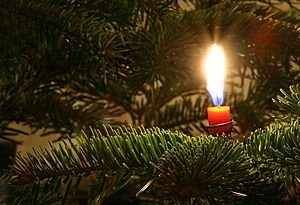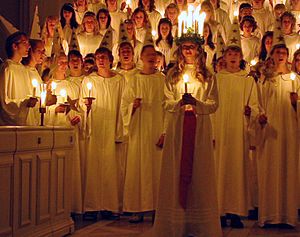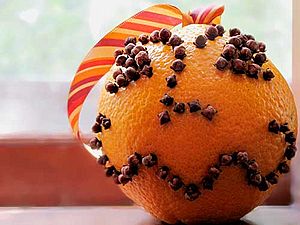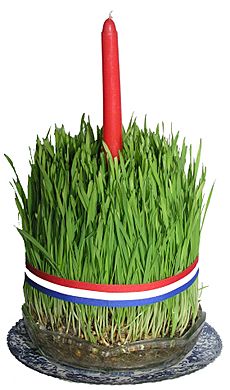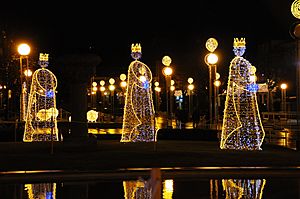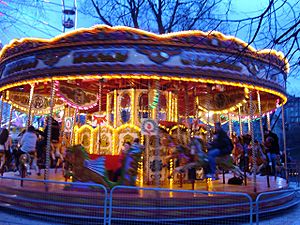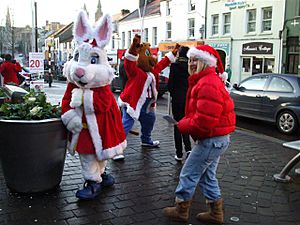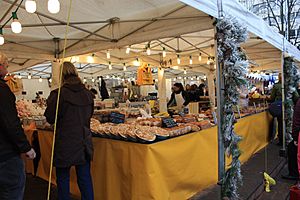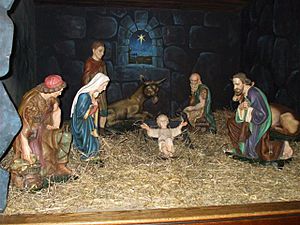Observance of Christmas by country facts for kids
Christmas is celebrated in many different ways across the globe. While December 25 is the main day, some countries also celebrate on the day before (Christmas Eve) or the day after (Boxing Day). Many governments and cultures recognize Christmas, even in places where Christianity is not the main religion. Sometimes, old colonial rule brought the celebration, like in Hong Kong. Other times, Christian groups or foreign influences led people to enjoy the holiday.
Many Christmas traditions include setting up and lighting Christmas trees, hanging Advent wreaths, Christmas stockings, and candy canes. People also leave out cookies and milk, and create Nativity scenes showing the birth of Jesus. You might hear Christmas carols and stories about figures like the Christ Child, Saint Nicholas, Santa Claus, Father Christmas, Christkind, or Ded Moroz. Sending Christmas cards, attending special church services like midnight Mass, burning a Yule log, and giving and receiving presents are also common. Christmas is a very important time in the Christian calendar, often linked to other holidays like Advent, Saint Nicholas Day, Saint Stephen's Day, New Year's, and Epiphany.
Many countries make Christmas an official public holiday. Others recognize it symbolically but not legally. Some countries where Christmas is not a public holiday include China (except Hong Kong and Macau), Japan, and Turkey. In places like Japan, even though it's not a holiday and there are few Christians, Christmas is still popular. People enjoy the fun parts like gift-giving, decorations, and Christmas trees.
Christmas celebrations can look very different from one country to another. This is because they mix with local cultures and traditions. Even in countries with strong Christian roots, Christmas celebrations have changed to include local customs.
Contents
Christmas Around the World
Africa
Ethiopia and Eritrea
Christmas Day is a holiday in Eritrea and Ethiopia. It is celebrated on January 7. Christmas is called Ledet in Eritrea and Gena in Ethiopia. Many Christians in these countries fast for 40 days before Christmas. They go to church early on Christmas morning.
On Christmas Day, there are colorful music celebrations. Priests wear special robes and perform rituals, including dancing and playing drums. Everyone dresses in white and goes to church at dawn. Later, people play a game called Gena, which is like hockey. An old Ethiopian story says shepherds played this game when Jesus was born. The community leader watches the game and gives a prize to the winner. Most Ethiopians wear a traditional white cotton wrap called a Shamma. After Christmas, there is a three-day festival called Timkat starting on January 19. It celebrates Jesus Christ's baptism.
Nigeria
Christmas Day is a holiday in Nigeria. Many people who have moved to towns and cities return to their home villages. They visit family and help those who are less fortunate. Before Christmas, markets are busy with people buying live chickens, goats, and cows for Christmas meals.
On Christmas Eve, families prepare traditional meals. Nigerians often cook large amounts of different meats. In the south, Jollof rice is served with meat stews, boiled beans, and fried plantains. In the north, Rice and Stew, or Tuwon Shinkafa (a rice pudding with meat stews), are popular. Some northern areas also make special local desserts. Another popular dish, especially in the south, is pepper soup with fish, goat, or beef. This can be served with Fufu (pounded yam). People drink traditional palm wine or local beers. Children and women often have local soft drinks.
Gift giving in Nigeria often involves money. Gifts flow from those who are better off to those who are less fortunate. Visitors from cities or overseas are asked for help, often financial. Money and wrapped gifts are given at parties and ceremonies. Sometimes, money is thrown in the air for others to grab.
South Africa
Christmas in South Africa is a holiday on December 25. Many European traditions are still followed here.
Christmas trees are set up in homes. Children receive presents in their stockings. Traditional fir trees are popular. Children leave out a stocking or milk and cookies for Santa Claus on Christmas Eve. Santa Claus brings the gifts. Towns and cities have Carols by Candlelight events. People sing Christmas carols and donate toys and clothes to children in need.
The Christmas meal includes mince pies, turkey, gammon, beef tongue, or roast beef. Many families have a barbecue outdoors. Dessert is often Christmas Pudding, ice cream, or trifle. Christmas crackers are used to make noise. Even though Christmas is in the middle of summer in South Africa, decorations often show winter scenes from the Northern Hemisphere.
Senegal
Christmas is a popular holiday in Senegal, even though most people there are Muslim.
Americas
Caribbean
Bahamas
Junkanoo festivals happen on Boxing Day (December 26) and New Year's Day. This is a local cultural event with African roots. It features goat skin drums, cowbells, and brass instruments. Dancers wear colorful, handmade costumes and perform in parades.
Bahamian Christmas foods include benny cake, coconut cake, fruit cake, baked ham, and turkey. Traditional peas and rice, baked macaroni, coleslaw, plantains, fried fish, and Johnny cake are also popular. Drinks like eggnog, lemonade, and local beers are served.
Cuba
Cuba used to have a long tradition of Christmas celebrations. Families would gather for dinner and then go to mass.
The government stopped the Christmas holiday in 1969 to focus on the sugar harvest. In 1998, December 25 became a leisure day again, after Pope John Paul II asked for it. It is a one-day holiday, celebrated mostly in the evening.
Jamaica
Radio stations start playing Christmas carols as early as October. Jamaicans paint their houses and hang new curtains for Christmas. Christmas lights, called pepper lights, go up on trees.
Junkanoo or John Canoe is a traditional Jamaican Christmas celebration. It has African influences. This includes street dancing and a parade with people in colorful costumes and masks. A traditional Jamaican Christmas breakfast includes ackee, saltfish, breadfruit, fried plantains, boiled bananas, and fresh juice. Dinner often has chicken, curried goat, stewed oxtail, rice, and gungo peas. For dessert, sorrel drink and Jamaican rum fruitcake are common.
Many people go to church on Christmas Eve or Christmas morning. Some go to the Christmas Eve Grand Market to shop and walk with family until early Christmas Day. Some British traditions, like Father Christmas, roast dinners, and Boxing Day, are still part of Jamaican Christmas.
Central America
El Salvador
Christmas in El Salvador is a strong family holiday. People focus on the birth of Jesus. Streets are busy and filled with red, green, and white decorations.
Children celebrate by playing with firecrackers and sparklers. Teenagers use bigger fireworks. Families also have parties with dancing and food. Santa Claus is seen in ads, but children are often asked if they wrote a letter to baby Jesus. Traditional Salvadoran Christmas dishes include turkey sandwiches on baguettes, Salvadoran Tamales, and sweet bread. Drinks like hot chocolate, pineapple juice, and Salvadoran horchata are served. At midnight on December 25, families gather around the Christmas tree and open presents.
Guatemala
On Christmas in Guatemala, people dress up in a special hat called a Puritina. They dance in a line. The celebration mixes Spanish and Mayan traditions.
North America
Christmas is widely celebrated on December 25. It is a federal holiday in the United States and a nationwide holiday in Canada and Mexico.
Canada
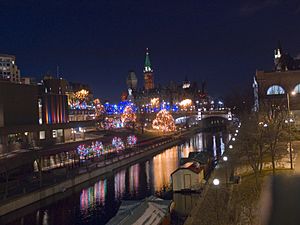
In English-speaking Canada, Christmas traditions are like those in the United States, with some British influences. Mince pies, plum pudding, and Christmas cake are traditional desserts after a meal of roast turkey, stuffing, and vegetables. Christmas table crackers are common. In some parts of Newfoundland and Labrador, Prince Edward Island, and Nova Scotia, people celebrate with mummers.
North American influences include hanging stockings for Santa Claus to fill. Canadian children believe Santa Claus lives at the North Pole, in Canada. They send thousands of letters to him each year through Canada Post. Decorating Christmas trees became popular in Canada in 1781. German soldiers in Quebec brought this tradition. Now, trees are common in homes and public places.
Canada has cold, dark winters, so many lights are put up in November and December. Cities have light festivals, like the Cavalcade of Lights Festival in Toronto. A national program, Christmas Lights Across Canada, lights up Ottawa and the provincial capitals.
In Quebec, Christmas traditions include réveillon (a late dinner), Père Noël (Father Christmas), and the bûche de Noël (Yule log). A traditional dish for réveillon is tourtière, a savory meat pie. Gifts are opened during réveillon, often after Midnight Mass.
The Royal Christmas Message from the Canadian monarch is shown on TV. This connects Canadians with other Commonwealth countries. Boxing Day on December 26 is a tradition in Canada, like in other English-speaking countries. It is a day for big sales at stores, attracting many shoppers.
Christmas is called Quviasukvik in Nunavut, the Northwest Territories, Yukon, and other Inuit areas. The Inuit celebrate it as their new year.
Greenland
Christmas in Greenland is usually celebrated on the evening of December 24 and during the day on December 25. December 26 is also a Christmas day. The Christmas season starts on the first Sunday of Advent. Christmas trees are put up and decorated. Villages also place a large Christmas tree on a nearby hill. Christmas is known as Quviasukvik, and the Inuit celebrate it as their new year.
Mexico
Christmas is a holiday in Mexico. Mexican Christmas is full of over 30 unique traditions. For nine days, groups of people go door-to-door, like Mary and Joseph looking for shelter. They are invited into homes to break a candy-filled piñata.
Mexican Christmas celebrations start on December 12 with the feast of La Guadalupana (Virgin of Guadalupe). They end on January 6 with the Epiphany. Since the 1990s, many celebrations around Christmas are linked in what is called the Guadalupe-Reyes Marathon. At midnight on Christmas, families place a figure of baby Jesus in their nacimientos (Nativity scenes). In central and southern Mexico, children receive gifts on Christmas Eve and on January 6. On January 6, the Three Wise Men bring gifts, just as they did for baby Jesus. Santa Claus also brings gifts, but traditionally the Three Wise Men fill children's shoes with candies, fruits, nuts, and sometimes money.
United States
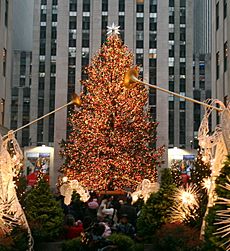
Christmas is a widely celebrated holiday in the United States. Christmas Day is a federal holiday. The Christmas and holiday season begins around late November with Black Friday shopping. Many schools and businesses close between Christmas and New Year's Day. This time is often spent with family and friends. Most decorations are taken down by New Year's or Epiphany. Other holidays like Hanukkah and Kwanzaa are also celebrated during this season. December 26 is known as the "Day after Christmas" but is not a federal holiday. Christmas is called Quviasukvik in Alaska. The Inuit, Yupik, Aleut, and Iñupiat celebrate it as their new year.
Houses are decorated inside and out in the weeks before Christmas Eve. Families get Christmas trees from farms or buy artificial ones. The tree is usually in the center of the home. It is decorated with ornaments, tinsel, and lights. An angel or star is placed at the top.
Christmas Eve is known as "the night before Christmas". Santa Claus is said to visit homes while children sleep. Many homes now have electric fireplaces, but the yule log tradition remains. Christmas stockings are hung on the mantelpiece for Santa to fill with small gifts. Children often leave milk and Christmas cookies for Santa.
Presents are wrapped and placed near the tree. Friends exchange gifts and agree not to open them before Christmas. Families visit or host grandparents, aunts, uncles, and cousins. Most presents are opened on Christmas Day morning. Some families open gifts on Christmas Eve. Children usually play with their new toys afterward.
Traditional Christmas dinner often includes roasted turkey with stuffing, ham, or roast beef. Potatoes, squash, roasted vegetables, and cranberry sauce are served. Tonics and sherries are common drinks. Sweet pastry and egg nog with cinnamon and nutmeg are popular desserts. Some families make special dishes using secret family recipes. Fruits, nuts, cheeses, and chocolates are enjoyed as snacks.
Other traditions include special church services on the Sunday before Christmas and Midnight Mass on Christmas Eve. Candlelight services are held earlier for families with children. A re-enactment of the Nativity of Jesus called a Nativity play is also a tradition.
Christmas attractions like the Rockefeller Center Christmas tree in New York City are very popular. Christmas music is heard everywhere. The Mormon Tabernacle Choir is famous for its carols. Local radio stations may play only Christmas music. Some TV stations show a Yule Log for hours. News shows feature Christmas segments about kindness. Christmas is also important for military families with members serving abroad. The NBA schedules five games on Christmas Day.
South America
Brazil
Christmas Day on December 25 is a holiday in Brazil. Since Brazil is in the Southern Hemisphere, Christmas is celebrated in the summer. In cities like São Paulo and Rio de Janeiro, celebrations are similar to Europe and North America. They include Christmas trees, gift exchanges, lights, and nativity scenes. Despite the warm weather, winter decorations are common. Some cities have decoration contests. Christmas Eve is the most important day. Celebrations happen near midnight with big family dinners, gift opening, and "Missa do Galo" (rooster's Mass) in churches.
Many Brazilians decorate their homes with a Christmas Tree. Parents might decorate it as a surprise or with their children. Nativity scenes are very popular. Christmas dinner is usually served late on Christmas Eve, around 10 or 11 p.m. The meal often includes farofa stuffing, fruits, fried cod, and roast turkey. Dessert is often "rabanada". People drink champagne, wine, and fruit punch. After eating, many attend Midnight Mass or watch the Pope's Mass on TV.
Colombia
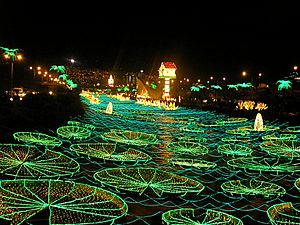
Christmas is a holiday in Colombia and is mainly a religious celebration. Presents are brought by El Niño Jesus / Niño Dios (Baby Jesus).
Christmas decorations go up in early November. The unofficial start of Colombian Christmas is December 7, Día de las Velitas ("Day of the Candles"). At night, streets, sidewalks, and balconies are lit with candles and paper lanterns. This honors the Immaculate Conception on December 8. Neighborhoods often decorate together, creating "tunnels of light." Many cities have musical events and fireworks. Medellín is famous for its Christmas lights. Individual fireworks used to be common but are now mostly banned. Cities or towns hold firework displays instead.
December 16 is the first day of the Christmas Novena. This is nine days of prayer, ending on Christmas Eve. The Novena is important for Catholics. It helps people remember the religious meaning of Christmas. Families set up a "pesebre" (manger scene). They sing religious Christmas carols called villancicos with instruments. They read Bible verses. Children play an active role in the Novenas. From December 16 to 24, games called "aguinaldos" are played. Churches offer masses during the novena, ending with the Misa de Gallo (Rooster's Mass) at midnight on Christmas Eve.
Christmas Eve is the most important day. Families and friends pray the last Novena. They wait until midnight to open presents. Parties last until sunrise on Christmas Day. Kids stay up late playing with new gifts. Fireworks fill the sky. Families gather for meals, music, and singing. Because Christmas Eve is so important, December 25 is quieter. Families attend Christmas Day mass, but it is less festive.
The "Dia de los Santos Inocentes" (Day of the Innocents) is on December 28. It remembers the infants killed by King Herod. January 6, Epiphany, is called "Reyes Magos" (from The Three Magi). It used to be a day for gift-giving, but now gifts are mostly given on Christmas Eve. Some families still give presents, and godparents often give gifts on this day.
Venezuela
In Venezuela, Christmas is a religious occasion. Presents are brought by "El Niño Jesus" (Baby Jesus), though "Papá Noél" (Santa Claus) is also important.
Christmas festivities unofficially start after the "Feria de la Chinita" in mid-November. This festival honors the Virgin Mary of Chiquinquirá with religious activities and music. It takes place in the Zulia Region. Other cities then join the celebrations with music and fireworks.
Many cities have "patinatas" night festivals. Children play with skateboards, rollerblades, and bicycles. Local churches often sponsor these events. Neighbors sell typical Christmas food, hot chocolate, hallaca, and cookies. In some neighborhoods, "Parranda" groups go house to house with music and carols. They receive food and drinks. In the Venezuelan Andes, a similar tradition called "Paradura del Niño" involves carrying an image of baby Jesus. Children write letters to Baby Jesus. Presents are delivered at midnight. Most people party until sunrise.
Asia
Central Asia
Uzbekistan
Christmas is not an official holiday in Uzbekistan. About 2.2% of the population is Russian Orthodox. This number has decreased since the fall of the Soviet Union. Christians celebrate Christmas on December 25 in the Julian calendar, which is January 7 in the Gregorian calendar.
During Soviet rule, religious celebrations were discouraged. Many Christmas traditions moved to New Year's. Christmas is still less important than New Year's Day in Uzbekistan.
Christmas decorations like those in Europe or the US are seen in cities. But for most people, they are part of New Year celebrations. Many people, including Muslims, decorate a Christmas tree. They call it a New Year's tree.
East Asia
China
December 25 is not a legal holiday in China. However, it is a public holiday in Hong Kong and Macau. These were former colonies of the United Kingdom and Portugal.
In mainland China, a small number of Christians celebrate Christmas privately. Many others celebrate Christmas-like events even if they are not Christian. Customs like sending cards, exchanging gifts, and hanging stockings are similar to Western celebrations. Christmas decorations and signs are common in big cities in December. This shows interest in Western culture and is also used for shopping promotions.
Hong Kong
In Hong Kong, Christmas is a public holiday. Many buildings facing Victoria Harbour are decorated with Christmas lights. Christmas trees are in malls and public buildings, and some homes. Catholics can attend Christmas Mass.
Hong Kong was greatly influenced by British culture. Christmas is one of the most important festivals after Lunar New Year. The Christmas atmosphere is very strong. Both Christmas Day (December 25) and Boxing Day (December 26) are public holidays. The custom of celebrating Christmas became common in the 1970s. Even though only about one-eighth of Hong Kong's population is Christian, the Christmas spirit is strong. People see it as a time for vacation, travel, carnival, and meeting friends.
Shopping malls start putting up Christmas decorations in mid-November. Buildings along Victoria Harbour are lit up. A giant 15-meter Christmas tree is set up in Statue Square. Many people start Christmas activities in early December, like parties, dinners, and gift exchanges. Christian leaders publish Christmas announcements on Christmas Eve. December 24 is not a holiday, but some offices let employees leave early. The stock market is only open in the morning.
Christmas Eve night is the busiest time. Areas like Tsim Sha Tsui and Lan Kwai Fong are crowded with people enjoying lights and carnivals. Churches hold Midnight Mass. Most shops, restaurants, and entertainment venues stay open. Public transport runs all night on Christmas Eve. Schools have Christmas holidays until New Year's Day. This makes Christmas and Lunar New Year the longest holidays besides summer. Young people often spend holidays with partners, like another Valentine's Day.
People in Hong Kong usually open gifts on Christmas Eve or Christmas morning. Some children write to Santa Claus. The Post Office staff pretend to be Santa and write back. Some Hong Kong people celebrate Christmas with the Winter solstice until New Year's Day.
Macau
Christmas is a public holiday in Macau. Its traditions are mostly from Portugal, as it was a Portuguese colony. Casinos in Macau stay open on Christmas Day. Christmas masses in Catholic churches are held in Chinese or Portuguese.
Japan
Christmas is popular in Japan, even though it's not a national holiday. This is due to businesses promoting it. Gifts are sometimes exchanged. Christmas parties are held. Japanese Christmas cake, a white sponge cake with cream and strawberries, is often eaten. Stollen cake is also available. Christmas lights decorate cities, and Christmas trees are in homes and malls. Christmas Eve has become a romantic day for couples to spend time together and exchange gifts.
A successful ad campaign in the 1970s made eating at KFC a Christmas custom. Their chicken meals are so popular that people reserve them months ahead.
The first recorded Christmas in Japan was a Mass in 1552. Christianity was banned in 1612, but some "hidden Christians" continued to practice. Christmas reappeared in the Meiji period. It became popular for non-Christians after the Russo-Japanese War. During World War II, celebrations were stopped. From the 1960s, with a growing economy and American TV, Christmas became popular. Many songs and TV shows present Christmas as romantic. The birthday of the previous emperor, Akihito, on December 23, was a national holiday. Businesses close for New Year's holidays, reopening after January 3.
South Korea
Christmas is a public holiday in South Korea.
Christmas traditions mix with Korean culture and food. Christians especially celebrate Christmas.
Taiwan
Only about 5% of Taiwan's population is Christian. So, Christmas is not usually a religious event. Before 2001, December 25 was a national holiday (Constitution Day). In recent years, the non-religious celebration of Christmas is growing. Christmas parties are held, and gifts are sometimes exchanged. Major cities and malls are decorated with Christmas lights and trees in December. One popular event is Christmasland in New Taipei City. It has Christmas activities and art displays. Events like family garden parties, parades, and concerts are often held.
South Asia
Bangladesh
Christmas is called Boro Din (Big Day) in Bangladesh. Pitha, cookies, and cake are prepared by Christians during Christmas. Christmas is a one-day public holiday. On Christmas Eve, churches hold a large dinner called preeti bhoj. It includes pulau, egg korma, fish fry, and vegetable curries. Prayers are held in church on Christmas Eve and Christmas morning. Carol performances follow the prayers. Churches are decorated with lights and Christmas trees. Some Christians also decorate their homes and give money or toys to children.
Christmas is also increasingly celebrated by other religions in Bangladesh, especially in cities. People celebrate by going to theme parks, zoos, and museums. They host small Christmas parties or exchange gifts.
India
India was a British colony until 1947, so many British traditions remained. Christmas is a state holiday in India. Christians are a minority, making up about 2.3% of the population. Most Christians, especially Catholics, attend midnight mass. Many Christian homes decorate Christmas cribs and hang brightly lit stars outside. They give sweets and cakes to neighbors. In schools run by Christian missionaries, children take part in Christmas programs. Many non-religious schools also celebrate Christmas. Other religions in India are also increasingly celebrating Christmas. Christmas is known as "Badaa Din" (Big Day) in North and North-West India. People plant trees on this day.
Pakistan
Christians are the second largest religious minority in Pakistan after Hindus. About 1.6% of the population is Christian. Half are Roman Catholic, and half are Protestant. Christians celebrate Christmas by going house to house singing carols. Families offer something to the choir in return. Money collected from carols is often used for charity or given to the church. Homes are decorated with local Christmas crafts. Artificial stars, like the Star of Bethlehem, are hung on rooftops. Christmas celebrations are also popular with the urban middle class. Hotels, cafes, restaurants, and theme parks host festivities.
Southeast Asia
Brunei
Since December 22, 2015, Christmas celebrations are mostly banned in Brunei. This includes Christmas trees, carols, nativity plays, greetings, and dressing as Santa Claus. However, Christian residents can celebrate privately. About 20% of the population is non-Muslim. Anyone caught breaking the ban can face up to five years in jail. Before 2014, non-Muslims could celebrate Christmas freely.
Indonesia

Christmas in Indonesia, called Natal, is a public holiday. About 16.5 million Protestants and 6.9 million Roman Catholics celebrate with various traditions. In provinces with many Christians, like North Sumatra and Jakarta, the Christmas season is full of ceremonies and festivals. In big cities, shopping centers and offices are decorated with plastic Christmas trees and Sinterklas (from the Dutch word Sinterklaas). Local TV channels broadcast Christmas concerts and national celebrations. On Christmas Eve, people go to church for Misa. They go again the next morning. Exchanging gifts is common for Christians. Besides traditional foods, Christmas Day often includes cookies like nastar (pineapple tart) and kastengel.
Malaysia
Christmas is a public holiday in Malaysia. Most public celebrations are commercial and not religious. Christian groups sometimes buy newspaper ads for Christmas or Easter, but this is usually only allowed in English newspapers. There has been debate about whether the government pressures Christians not to use religious symbols or hymns that mention Jesus.
Philippines
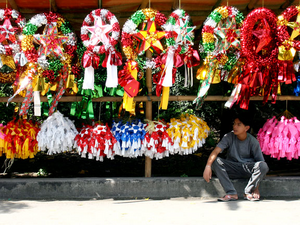
Christmas in the Philippines, a mostly Catholic country, is one of the biggest holidays. It has the longest Christmas season in the world. Carols are heard as early as September 1. The season officially begins with nine-day dawn Masses starting on December 16. These are called Misas de Aguinaldo or Misa de Gallo. They are held in Catholic churches nationwide. Besides legal holidays like Rizal Day (December 30) and New Year's Eve (December 31), Christmas Eve (December 24) and Epiphany (January 6) are also often non-working days.
Secular Christmas displays are common in businesses and public places. These include lights, Christmas trees, and Santa Claus figures, despite the tropical climate. Parols, representing the Star of Bethlehem, are often left up even in summer.
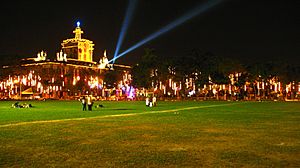
For Filipinos, Christmas Eve (Bisperas ng Pasko) on December 24 is celebrated with Midnight Mass. Immediately after, families have the Noche Buena, a traditional Christmas Eve feast. Family members dine around midnight. The meal may include queso de bola (Edam cheese), tsokolate (hot chocolate), jamón (Christmas ham), lechón (roast pig), roast chicken or turkey, pasta, and various desserts. Some families open presents at this time.
On December 31, New Year's Eve (Bisperas ng Bagong Taon), families gather for the Media Noche (midnight meal). This feast symbolizes hopes for a prosperous New Year. Many Filipinos still use firecrackers to greet the New Year, despite campaigns against them. Loud noises are believed to drive away bad spirits. Safer ways to celebrate include banging pots and blowing car horns. Folk beliefs include children jumping at midnight to grow tall. People display circular fruits and wear clothes with dots to symbolize money. Eating twelve grapes at midnight brings good luck for each month. Opening windows and doors on New Year's Day lets in good luck.
Christmas officially ends on the Feast of the Three Kings (Tres Reyes). This is also known as the Feast of the Epiphany. It was traditionally on January 6, but now it's on the first Sunday after New Year's. Some children leave their shoes out for the Three Kings to leave gifts like candy or money. The celebrations can extend until the end of January, with feasts like the Black Nazarene and Santo Niño.
Singapore
Christmas is a public holiday in Singapore and is widely celebrated. The Christmas season is popular for shopping centers to have year-end sales. The famous shopping area Orchard Road and Marina Bay are decorated with lights from early November to early January. The lights and decorated malls attract many visitors. Other activities like caroling and concerts happen on Orchard Road. Companies in Singapore usually arrange gift exchange programs before Christmas.
Thailand
Christmas is not an official public holiday in Thailand. Most of the population follows Buddhism.
Vietnam
Christmas is not a national holiday but is becoming popular in Vietnam. Wealthier Vietnamese enjoy Christmas for its non-religious glamor and shopping appeal. Locals are more exposed to Western culture. Their way of celebrating Christmas might seem different to Westerners. Vietnamese may accept commercial influence because Christmas was not based on personal values for them. It is not a time for family dinner or showing thanks. Instead, it is a time to go out, shop, and take pictures with friends, especially on December 24. This is the second most popular holiday after Vietnamese New Year.
Christmas is banned in Vietnam's Central Highlands. Some observers have reported harassment by authorities.
West Asia
Armenia
Armenians usually celebrate Christmas on January 6. This date comes from ancient history. In the fourth century, the Roman Catholic Church set Christmas on December 25. Before that, Armenians celebrated Christmas (surb tsnunt, "Holy Birth") on January 6 as a public holiday. It also matches Epiphany. Armenians kept celebrating both the Nativity and Jesus’ baptism on January 6. When the Gregorian calendar was used in 1582, Armenians stuck to the Julian Calendar. Today, only the Armenian Patriarchate of Jerusalem still uses the Julian Calendar. Since the Julian calendar is 13 days behind, January 6 on the Julian calendar is January 19 on the Gregorian calendar.
Traditionally, Armenians fast for the week before Christmas. They avoid meat, eggs, and dairy. Devout Armenians might fast for three days before Christmas Eve. Christmas Eve is rich in traditions. Families gather for dinner (khetum). It usually includes rice, fish, nevik (a vegetable dish), and yogurt/wheat soup (tanabur). Dessert includes dried fruits and nuts, like rojik and bastukh. This lighter meal prepares the stomach for Christmas Day. Children take gifts of fruits, nuts, and candies to older relatives. On Christmas Eve, the Jrakalouyts Divine Liturgy (lighting of lamps service) is celebrated. Armenians also set up a Nativity scene. Christmas in Armenia is a religious event. Santa Claus does not visit on Christmas. He visits on New Year's Eve. He was called kaghand papik before the Soviet Union. Now he is called Grandfather Winter (dzmerr papik).
Assyrians
The Assyrians celebrate Christmas on December 25. They call it Eda Zora (little holiday) or Eda d'Yalde (birthday holiday). Traditionally, Assyrians fast from December 1 until Christmas Day. In Iraq, on Christmas Eve, Assyrian families gather outside their homes with lighted candles. A child reads the nativity story. They sing psalms over a bonfire made of thorn bushes. A story says if the thorns burn to ashes, the family will have good luck. After the fire, family members jump three times over the ashes and make a wish. On Christmas Day, bishops lead a service carrying a figure of baby Jesus. They bless people with a touch of peace. Many Assyrians attend the Shaharta (midnight vigil). On Christmas Day, after church, the fast is broken. They eat traditional foods like pacha/reesh-aqle (boiled soup from sheep or cow parts) or harissa (wheat and chicken porridge). These dishes are only made on Christmas and Easter. Desserts include Killeche (date and walnut cookies) and Kadeh (stuffed pastry). After the meal, Assyrians visit family and friends to exchange greetings, saying, "Eedokhon breekha" (May your feast be blessed). Hosts serve tea, Turkish coffee, and cookies. While Christmas is very religious, families now often put up a small Christmas tree.
Lebanon
Christmas is an official holiday in Lebanon. Most Lebanese celebrate on December 25. Armenian Lebanese celebrate on January 6, which is also a holiday. Lebanese families butcher a sheep for a Christmas Eve feast, honoring the birth of Jesus. The head of the house passes around a piece of coal, symbolizing sins before Christ. It is then set on fire. After dinner, Christian Lebanese attend midnight mass. Santa Claus is known as Papa Noël. Gifts are left at church or Papa Noël visits homes.
Jordan
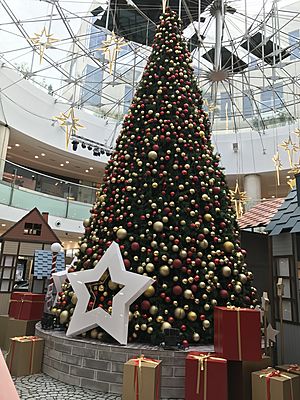
Jordanian Christians celebrate Christmas on December 25. The Muslim majority also takes part in Christmas as a holiday. Shops and streets in Jordan are colorfully decorated during this time.
Iraq
Christmas is celebrated by Christians in Iraq. In 2018, it became an official state holiday for the first time. More Muslims have also started celebrating Christmas as a non-religious holiday.
Europe
Central Europe
In Central Europe (Germany, Austria, Switzerland, Czech Republic, Poland, Slovakia, Hungary, Slovenia), the main celebration is on Christmas Eve (December 24). This day is usually a fasting day. Children are sometimes told they will see a golden pig if they fast until dinner. When evening comes, Christmas Dinner is prepared. Meals vary by region. In Poland, Czech Republic, and Slovakia, fried carp with potato salad and fish soup are common. Some places have a simple porridge, while others have up to 12 dishes. Children may receive presents from neighbors and guests. Pets might also get gifts.
After dinner, it's time for gifts. Children usually find gifts under the Christmas Tree with name tags. There's a history of different Christmas figures. During communism, Ded Moroz (Grandfather Frost) was promoted instead of Little Jesus. Now, Santa Claus is becoming popular through ads and movies. Many people, Christian or not, go to Roman Catholic midnight mass.
Other common Christmas items in Central Europe include Christmas trees, mistletoe, garlands, and Bethlehem cribs.
In many parts of Central Europe, St. Nicholas (Mikulás) does not come for Christmas. He visits families earlier, on December 6 (St. Nicholas Day). He brings presents and candy bags for well-behaved children. They put their polished shoes in the window the night before. He doesn't use a sleigh or chimney. He is often joined by Krampusz (Krampus), a devil-like servant. Krampus gives golden birches to naughty children. In reality, all children usually get both gifts and birches.
Austria and Germany
In some German-speaking areas, especially Catholic regions, the Christkind (Christ child) brings presents on the evening of December 24. The Christkind is invisible. It rings a bell to let children know the tree and presents are ready.
Christmas trees are decorated in the days before Christmas or on Christmas Eve morning. Late on Christmas Eve, after the bell rings, the tree is shown to the children, and presents are exchanged.
Protestant churches have a service called Christvesper in the late afternoon. It includes readings, the Christmas Gospel, a Krippenspiel (nativity play), carols, and music. Some Lutheran churches also have a candlelight service at midnight.
Many Catholic churches have a first Mass of Christmas, Christmette, around 4 p.m. for families. The crib is very important in Catholic areas like Bavaria.
Austria
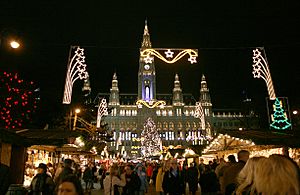
In Catholic Austria, Christmas markets are a long tradition. In Vienna, one market is in front of City Hall. Innsbruck has a market in its medieval square. In Salzburg, the market is in front of the cathedral. Almost every small town has its own Christmas market.
Christmas trees are very important. Every town sets up a huge tree in the main square. It's decorated with electric candles and ornaments. Families decorate their trees with gold and silver ornaments, straw stars, and wrapped candies.
The feast of Saint Nicholas marks the start of Christmas. On Christmas Eve (December 24), the tree is lit for the first time. The family gathers to sing carols like "Silent Night". Gifts under the tree are opened after dinner. Austrian tradition says the Christ Child decorates the tree and brings presents. Children send their wish lists to him. Christmas Eve dinner is the main event, often with fried carp. Vanillekipferl, Zimtsterne, and gingerbread are common sweets.
Germany
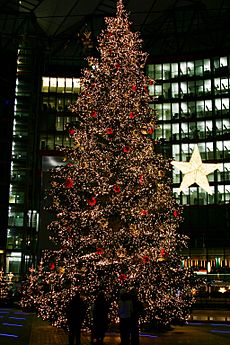
In Germany, Christmas traditions vary by region. Before the Reformation, Saint Nicholas Day on December 6 was when presents were given. Nikolaus still puts goodies in children's shoes on that day. Sometimes St. Nicholas visits schools. Children recite a poem or sing a song to get sweets. "Knecht Ruprecht" (the servant Ruprecht) sometimes comes with St. Nicholas. He has a long red tongue and a stick. He warns naughty children.
The Sorbs, a minority group, have special traditions. In Jänschwalde, the Bescherkind (Janšojski bog - "presents kid") visits neighbors. It's a girl in local costume with a veil. She gives small presents and blessings. Wooden toymaking in the Ore Mountains is famous for Christmas decorations. Children can write Christmas letters to special post offices.
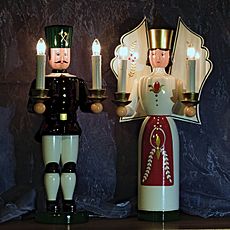
Today, gift-giving (German: "Bescherung") usually happens on Christmas Eve. This tradition was started by Martin Luther. He wanted to focus on Christ's birth, not a saint's day. Gifts symbolize God's grace. This custom spread to Catholic regions too.
Gifts may be brought by the Weihnachtsmann (Christmas man), who looks like Santa Claus. Or by Christkindl, a child-like spirit. Before 1930, there was a divide between the southern Christkind and northern Weihnachtsmann. After gifts are opened, children often stay up late.
The Christmas Tree is decorated on the morning of the 24th. Gifts are placed under it. Christmas church services are also a time to greet friends. After an evening meal, a parent lights the candles on the tree and rings a bell. Children then enter the room. Many families sing carols around the tree before opening presents. Some families attend a midnight church service.
The Christmas meal is on Christmas Eve or Christmas Day. Traditions vary. Carp is eaten in many areas. Potato salad with sausages is popular in some families. A simple meal like vegetable or pea soup is favored in regions where Christmas Eve is a fast day. In Schleswig-Holstein, a roasted duck or goose is traditional. Many families now have fondue or raclette. Families bake many kinds of Christmas cookies.
"Lüttenweihnachten" is a custom of decorating a Christmas tree with food for animals.
Czech Republic and Slovakia
Christmas Eve (December 24) is called Štědrý den/Štedrý deň ("Generous Day"). Gifts are given in the evening. December 25 and 26 are holidays. Vánoce/Vianoce (Christmas) is mostly linked to the 24th.
Tradition says Ježíšek/Ježiško ("baby Jesus") brings gifts. Fish soup and breaded roasted carp with potato salad are traditional for dinner. In Slovakia, people share a piece of Christmas wafer with honey and walnuts before eating. Traditional dinner varies, but cabbage soup or lentil soup is common. Gifts are secretly placed under the Christmas tree. Children wait for a Christmas bell to ring, meaning Ježíšek/Ježiško has passed by. They then run for presents. There are many hard-baked Christmas sweets.
Other Czech and Slovak traditions predict the future. Apples are cut crosswise. A perfect star means a good year. Girls throw shoes over their shoulders. If the toe points to the door, they will marry soon. Another tradition is pouring melted lead into water to guess shapes.
In Catholic Slovakia, young men dressed as shepherds or angels visit neighbors. They perform songs about Jesus' birth.
Hungary
The Christmas season starts early in Hungary. Mikulás (Hungarian Santa Claus) visits children's homes on the night of December 5. Children place a boot on their windowsill for him to fill with treats.
On Christmas Day, the Christ Child brings gifts. Celebrations begin on December 24 with tree decoration and gift wrapping. Then comes a family dinner with traditional Christmas meals. Some parts of Hungary serve fish soup halászlé on Christmas Eve. This day is otherwise a fast-day.

In the evening (Christmas Eve, Szenteste), the Angel or the Little (Baby) Jesus delivers presents. This is a special moment with a lit Christmas tree, carols, and gift opening. There is also a folk custom called 'playing Bethlehem'. Children or adults dress up and perform the story of Jesus' birth. They go house to house and receive gifts.
Poland


In Catholic Poland, Christmas Eve begins with fasting and then a feast. The traditional Christmas meal is Wigilia ("The Vigil"). Being invited to a Wigilia dinner is a great honor.
On Christmas Eve night, people watch for the first star, remembering the Star of Bethlehem. Children eagerly wait to be the first to shout, "The star has come!" After the star appears, the family sits down for dinner.
Bits of hay are spread under the tablecloth to remember Christ's birth in a manger. Some put money under the cloth for good luck. The dinner has twelve dishes, one for each Apostle. Many homes set an extra place for a lonely wanderer or the Holy Spirit.
Before eating, everyone exchanges Christmas greetings. The supper begins by breaking the opłatek. Sharing a piece of Opłatki symbolizes unity with Christ. The opłatek is blessed by a Bishop and stamped with a religious image.
A traditional Wigilia supper includes fried carp and barszcz (beetroot soup) with uszka (meatless ravioli). Other common dishes are fish soup, potato salad, pierogi, and pickled herring. For dessert, makowiec or noodles with poppy seed are common. A compote of dry fruits is often served. After supper, the Star Man arrives with Star Boys. They dress as Wise Men or animals. The Star Man tests children on their catechism and gives small presents if they do well. The Star Boys sing carols and receive treats. Gifts are exchanged after the meal.
The rest of the evening is spent with stories and songs around the Christmas tree. In some areas, children are taught that "The Little Star" brings gifts. Carolers may go house to house, receiving treats.
Christmas Eve ends with Pasterka, the Midnight Mass. This remembers the Three Wise Men visiting Bethlehem. The custom of Christmas night liturgy began in the 5th century. In Poland, it came with Christianity. The next day (December 25) starts with early morning mass. The following day is often spent visiting friends. The gift-bringer varies. In some regions, it's Święty Mikołaj (Saint Nicholas). In others, Saint Nicholas gives gifts on December 6, and the Christmas Eve gift-bringer is Gwiazdor ("star man"), Aniołek ("little angel"), or Dzieciątko ("baby Jesus").
Romania and Moldova
Christmas (Romanian: Crăciun) in Romania is on December 25. It is the second most important holiday after Easter. In Moldova, Christmas is celebrated on December 25 and January 7. Celebrations begin with decorating the Christmas tree on December 24. In the evening (Christmas Eve, Ajunul Crăciunului), Moş Crăciun (Father Christmas) delivers presents.
Carol singing is a very important part of Romanian Christmas. On Christmas Day, carolers walk through towns and villages. They carry a star made of cardboard and paper with Bible scenes. Small children go house to house singing carols and reciting poems. The group leader carries a wooden star decorated with bells and ribbons. An image of the Nativity is painted on the star.
Romanian Christmas food is a large meal, mostly pork. This is a symbolic gesture for St. Ignatius of Antioch.
Eastern Europe
Since the 1880s, Eastern Slavic countries have a character called Ded Moroz ("Grandfather Frost"). He travels in a magical sleigh pulled by reindeer or three white horses. With his granddaughter, Snegurochka (the "Snow Maiden"), he visits homes and gives gifts to good children. He delivers presents while children sleep. Unlike Santa, he comes to the front door. In Russia, children receive presents on New Year's Day. Christmas is celebrated by Christians on January 7.
Ded Moroz is not linked to Saint Nicholas of Myra. He is a Slavic tradition, and any connection to the saint has disappeared.
Georgia
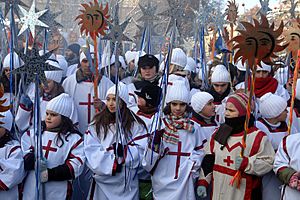
In Georgia, Christmas (shoba) is celebrated on January 7. It is traditional to go on Alilo, a mass walk in the streets. People dress in special clothes to celebrate. Most Alilo marchers are children, and adults give them sweets. Alilo carols vary by province. Many songs use the words: "on 25th December Christ was born in Bethlehem." A local Christmas tree, called Chichilaki, is made of soft wood with curled branches. It's decorated with fruits and sweets. Western Christmas trees are also popular. The Georgian "Santa Claus" is tovlis papa ("Grandfather snow"). He has a long white beard and wears a national costume.
Russia

Like some other Eastern Orthodox countries, Russia celebrates Christmas on January 7. This is due to the 13-day difference between the Gregorian and Julian calendars. Christmas is mainly a religious event in Russia. On Christmas Eve (January 6), there are long church services. Families return home for the traditional "Holy Supper" with 12 dishes, one for each Apostle. Devout families return to church for the "всеночная" All Night Vigil or watch it on TV from Moscow. On Christmas Morning, the Divine Liturgy of the Nativity is held. Since 1992, Christmas has been a national holiday in Russia.
During the Soviet era, religious celebrations were discouraged. Christmas trees and celebrations were removed after the October Revolution. In 1935, Christmas traditions were adopted as part of the secular New Year celebration. This includes decorating a tree (ёлка), festive decorations, and family gatherings. Ded Moroz (Grandfather Frost) and his granddaughter, Snegurochka (The Snowmaiden), visit and give gifts. Many of these traditions were brought to Russia by Peter the Great in the late 17th century.
Christmas is known as Quviasukvik in Chukotka Autonomous Okrug. The Chukchi, Yupik, and Aleut mark it as their new year on December 24.
Ukraine
Sviata Vecheria or "Holy Supper" is the main tradition on Christmas Eve in Ukrainian homes. It takes place on January 6. In Western Ukraine, Christmas can be celebrated twice: on December 25 and January 7. Since 2017, both dates are celebrated nationwide.
When children see the first star in the eastern sky, symbolizing the Three Wise Men, Sviata Vechera can begin. In farming areas, the head of the household brings in a sheaf of wheat called the didukh. This represents Ukraine's rich wheat crops and ancestors. In cities, a few stalks of golden wheat decorate the table. The dinner table sometimes has hay to remember the manger. A prayer is said, and the father says, "Chrystos rodyvsya!" ("Christ is born!"). The family replies, "Slavite Yoho!" ("Let us glorify him!"). At the end of Sviata Vecheria, the family sings Ukrainian Christmas Carols. In many communities, young people and church groups go caroling and collect donations.
Christmas Day for Ukrainian families starts with church services. Ukrainian churches offer services before midnight on Christmas Eve and on Christmas morning. Christmas supper, without fasting rules, has fewer traditions than Sviata Vecheria. The old tradition of giving gifts on St. Nicholas Day (December 19) has mostly been replaced by Christmas. Father Frost visits children in a sleigh pulled by three reindeer. (In Western Ukraine, St. Nicholas Day is on December 6.)
Northern Europe
In much of Northern Europe, Christmas is celebrated on December 24 and is called Jul (see Yule). December 25 is a relaxed day for visiting relatives. "Yule" may come from the Norse word for wheel, referring to the sun's movement. The Yule season was a time for feasting, drinking, gift-giving, and gatherings. It was also a time to be aware of dark forces. Many Yule practices remain in Advent and Christmas celebrations today.
Denmark

Danes celebrate on December 24, called Juleaften (Yule evening). The family meal includes roast pork, duck, or goose. It's eaten with potatoes, gravy, and red cabbage. Caramelized potatoes are important. For dessert, rice pudding is served with black cherry sauce. The pudding has a whole almond. Whoever finds it gets good luck and a small gift, Mandelgave. After the meal, the family gathers around the Christmas tree. They sing carols and dance in circles. Then, traditions vary. One child might hand out presents, or all children take turns. Sometimes "Santa Claus," the Julemanden, appears at the door with a sack of presents. He distributes gifts with help from the children. He should be offered a drink to keep him warm. Presents are opened, followed by snacks and a traditional drink called Gløgg.
Danes are known for their Julefrokost (Christmas lunch). It includes traditional Danish dishes, often with beer and Snaps. These lunches are popular for families and companies. They used to be before Christmas but are now often in November and January. Family Julefrokoster are usually on Christmas Day or December 26.
A newer Danish tradition is television Julekalendere. These are Christmas-themed TV shows with a daily episode for the first 24 days of December. They end on Juleaften. Many are for children and become very popular.
In Denmark, Santa Claus is Julemanden ("the Yule Man"). He arrives in a sleigh with presents. He is helped by elves called julenisser (or nisser). These elves are believed to live in attics or barns. To keep the nisser happy, children leave out milk or rice pudding. They are happy to find the food gone on Christmas morning.
Estonia
In the weeks before Christmas (jõulud), children place a slipper in their windows. They receive candy from visiting elves (päkapikud). Estonians celebrate Christmas on December 24, called jõululaupäev ("Christmas Saturday"). It is a public holiday. Each year, the President declares Christmas Peace and attends a service. This tradition started in the 17th century. Estonian children are visited by jõuluvana ("Santa Claus") on Christmas Eve. They must sing or recite poems before getting gifts.
The evening meal usually includes pork with sauerkraut, baked potatoes, and sausages. For dessert, Estonians eat gingerbread (piparkoogid) and marzipan. Popular drinks are beer and mulled wine (glögi). Estonians leave leftover food on the table overnight. They hope spirits of loved ones will visit and eat. It is also customary to visit graveyards and leave candles for the dead.
December 25 (jõulupüha) is a relaxed day for visiting relatives.
Finland
Christmas in Finland is a big family celebration with religious aspects. The season starts in December or late November. Shops advertise gifts. Decorations and songs become more common. Children count days with Advent calendars. Schools have a holiday on December 23. On Christmas Eve (jouluaatto, December 24), shops close early and stay closed until December 26. The main festivities are on Christmas Eve. Christmas Day (joulupäivä) and St. Stephen's Day (Tapaninpäivä) are public holidays. Schools have holidays until New Year's.
The Declaration of Christmas Peace is a tradition in Finland since the Middle Ages. It happens every year, except in 1939 due to war. The most famous declaration is in Turku at noon on Christmas Eve. It is broadcast on radio and TV. The ceremony starts with a hymn and the Declaration of Christmas Peace, read in Finnish and Swedish. It ends with the Finnish national anthem. Recently, there is also a declaration of Christmas peace for forest animals, so no hunting happens.
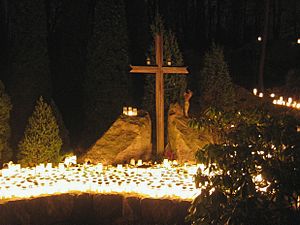
Finnish people clean their homes before Christmas and prepare special treats. A sheaf of grain is tied on a pole for birds. Spruce trees are brought home on or before Christmas Eve and decorated. Candles are lit on the tree, which is decorated with fruits, candies, and tinsel. Electric lights have replaced real candles. A star is placed at the top. Before festivities, people usually take a Christmas sauna. This is an old tradition.
Afterward, they dress in clean clothes for Christmas dinner (joulupöytä). It is usually served between 5 p.m. and 7 p.m., or when the first star appears. The most traditional dish is Christmas ham, or roasted fresh ham. Some prefer turkey. Several kinds of casseroles, like rutabaga and potato, are traditional. Other dishes include boiled codfish, pickled herring, and vegetables. Prune jam pastries, plum soup, rice porridge, and chocolates are popular desserts. Gifts are usually exchanged after Christmas Eve dinner. Children do not hang stockings. Joulupukki (Santa Claus) visits homes, sometimes with a tonttu (elf) to help.
Christmas Day services begin early. People visit families and have reunions.
Boxing Day, or tapaninpäivä (St. Stephen's Day), is for driving around the village (tapaninajot). This balances the solemn part of Christmas.
Iceland
Christmas or Yule (Jól in Icelandic) starts four Sundays before Christmas. It begins on December 24 (Advent) and ends thirteen days later on January 6. One candle is lit each Sunday until four are lit on the 24th. At 6:00 p.m., church bells ring to start the celebration. Religious Icelanders attend mass. Others begin their holiday meal. After the meal, they open gifts and spend the evening together. Icelanders often eat smoked lamb, ptarmigan, and turkey during the Yule holidays. Pork is also popular.
Thirteen days before December 24, children leave their shoes by the window. The Yule Lads leave small gifts in them. The Yule Lads are sons of trolls. Each is known for a different mischief. They traditionally wear wool clothing but are now known for red and white suits.
Each home sets up a Christmas tree indoors, usually decorated on December 11. Presents are placed under the tree. It is also a tradition to boil skate on December 23, called Saint Thorlak Mass.
During the holidays, families bake small cookies. Thin gingerbread cookies are common. Many families also make Laufabrauð (Leafbread), a flat thin bread.
The end of the year is divided into Old Year's Day (Gamlársdagur) and New Year's Day (Nýársdagur). On the night of the former, Icelanders shoot fireworks to welcome the new year.
Thirteen days after the 24th, Icelanders say goodbye to the Yule Lads and other creatures like elves and trolls. Bonfires are held, and people dance before saying goodbye until next Christmas.
Norway

The main celebration day in Norway is December 24. Most stores close early. Church bells chime the Christmas holiday between 5 p.m. and 6 p.m. Some families read the Christmas story from Luke 2. The main Christmas meal is served in the evening. Common dishes include pork rib, "pinnekjøtt" (steamed lamb rib), "lutefisk", or poached cod. Rice porridge is popular as an early lunch. An almond is often hidden in the porridge. The finder wins a treat. Some people place porridge outside for "Nissen" (elves). Many families serve two main dishes if parents have different traditions. If children are present and behaved well, "Julenissen" (Santa Claus) visits. Otherwise, gifts are under the tree.
For many Norwegians, TV is important on Christmas Eve. They watch the Czech-German fairy tale Three Nuts for Cinderella, the Disney Christmas show From All of Us to All of You, or the Norwegian movie Reisen til Julestjernen. Attending a play of Putti Plutti Pott and Santa's Beard is also popular.
December 25 is a quiet day. Church services are well attended. Many families gather for a large meal.
December 26 is also a day of festivities. Cinemas, clubs, and bars are busy. There are many private parties with traditional Christmas cookies and sweets. Fatty dinners are also part of it. The time between Boxing Day and New Year's Eve is called romjul. Children in some areas dress as "nisser" and "Julebukk" (Christmas goat). They sing carols for treats, like Halloween in America. January 6 is usually the end of Christmas. Some end it on the 20th day or at Candlemas.
Sweden
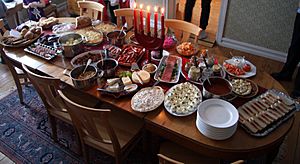

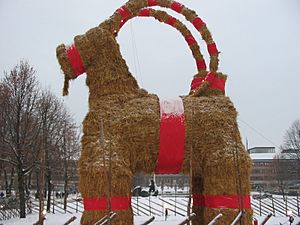
The pre-Christian holiday of Yule was very important in Scandinavia. It was about the winter solstice and the sun's rebirth. Many practices from Yule are still in Advent and Christmas. The Yule season was for feasting, drinking, and gift-giving. Swedish Christmas celebrations begin with the first of Advent. Saint Lucy's Day (Luciadagen) is the first major celebration. The eldest daughter wakes the family early. She wears a white robe, red sash, and a crown with nine lighted candles. She sings "Santa Lucia" and serves coffee and saffron buns.
Schools elect students to play Lucia and her maids. A national Lucia is chosen on TV. Regional Lucias visit malls and churches, singing and giving out gingerbread cookies.
Boys also join the procession. Some dress in white robes with star-shaped hats (stjärngossar). Some are "tomtenissar" with lanterns. Others dress as gingerbread men. They sing, often about Saint Stephen. Electric candles and glowing stars are in almost every window in December. December 25 (juldagen) is a public holiday. December 24 is when Santa Claus (Jultomte) brings presents. Christmas Eve is a de facto holiday, with most workplaces closed.
The Jultomte was originally a small, invisible house gnome. An old belief says to feed the Tomte with porridge on Christmas Eve. If not, he brings bad luck. The modern "Tomten" is like Santa Claus. He knocks on the door and asks, "Are there any nice children here?"
Christmas is celebrated with food. Most Swedish families have a Christmas table (julbord) on December 24. It includes Christmas ham (julskinka), meatballs, pickled herring, spareribs, hot dogs, salmon, and Janssons frestelse (potato casserole). Julmust and mulled wine (glögg) are served. The dishes vary by region. Businesses invite employees to julbord dinners.
Candies include marzipan, toffee, and nuts. Fruits like figs and oranges decorated with cloves are also popular.
Television is important. Many families watch the Disney Christmas special Kalle Anka och hans vänner önskar God Jul (From All of Us to All of You). After the julbord on December 24, presents are given out. They are usually from a sack or under the tree.
Many Swedes write a rhyme on each present to hint at the contents.
In older days, a yule goat was an alternative to Jultomten. Now it's an ornament, like the giant straw Gävle goat. If families celebrate with two groups, one might move their celebration to Christmas Day or December 23.
After December 24, Christmas celebrations mostly end. Some attend the julottan, an early morning church service on December 25. This was historically the main service. The Midnight Mass is now more popular. Many Swedes do not attend church during Christmas, as the country is very secular. Still, most families set up a Julkrubba (Christmas Crib). On January 13 (knutdagen), 20 days after Christmas, celebrations end. All decorations are removed.
Southern Europe
Bosnia and Herzegovina, Croatia and Slovenia
In Bosnia and Herzegovina, Croatia, and Slovenia, Christmas is mainly a religious holiday. Festivities begin on Saint Nicholas's Day (December 6 in Slovenia) or St. Lucy's Day (December 13 in Croatia). St. Lucy or St. Nicholas brings presents. St. Nicholas is said to be with Krampus, who steals presents from bad children. Krampus has a cloven hoof and chains. In Croatia, on St. Lucy's, families plant wheat seeds in a bowl. They grow by Christmas and are tied with a red, blue, and white ribbon.
On Christmas Eve (Croatian: Badnjak, Slovene: Sveti večer), three candles representing the Trinity are lit. They are placed in the wheat. The glow symbolizes each person's soul. On this day, the tree is decorated, and the home is decked with greenery. Women prepare the Christmas meal. They bake special breads: cesnica (round with a cross) and Christmas Eve Bread (with honey, nuts, dried fruit). In many villages, straw is spread on floors to symbolize Christ's birth. Meat is not eaten in Croatia on this day, but it is in Slovenia. Instead, salad and fish are served. The Dalmatian specialty bakalar (dried cod fish) is common. The family sprinkles holy water on their Yule log (badnjak), lights it, and watches. In villages, the father cuts the badnjak while saying prayers. At the end of the meal, a piece of cesnica is dipped in wine and used to put out candles, while saying a prayer.
Many families go to midnight mass on Christmas Eve and another on Christmas Day. Presents are often placed under the tree. This suggests the Angel or Baby Jesus leaves them while people are at mass. Presents are opened after mass. Christmas is a day for family celebration. A large feast is prepared. Traditional foods include stuffed cabbage, turkey, pot roast, and smoked meat. Desserts include fritule, potica, and cookies.
Slovenes are also visited by three "good guys" who bring presents in December: Saint Nicholas, Santa Claus, and Dedek Mraz ("Grandfather Frost"). Families celebrate New Year's Eve at home with relatives and friends. Women prepare cabbage sarma to eat on January 1 for good fortune. They eat steak tartare on New Year's Eve. At midnight, people watch fireworks. Dedek Mraz leaves presents under the tree. Epiphany on January 6 marks the end of Christmas.
Bulgaria

In Bulgaria, Christmas (Koleda) is on December 25. It is preceded by Christmas Eve (Badni vecher). Christmas Eve is the end of the Nativity Fast. Only an odd number of lenten dishes are served. The table is not cleared until morning, leaving food for holy spirits. This custom may come from pre-Christian times. On this day, a Bulgarian budnik is lit. On Christmas, meat dishes are allowed and typically served.
Among Bulgarian traditions is koleduvane. Boy carolers visit houses starting at midnight on Christmas Eve. They wish health, wealth, and happiness. Another custom is baking a traditional round loaf (pita). The head of the family breaks it and gives a piece to each family member, a valuable possession, and a piece for God. A coin is hidden inside. Whoever gets it will have luck and prosperity.
A Christmas tree is set up, and the house is decorated. The local name for Santa Claus is Dyado Koleda ("Grandfather Christmas"). Dyado Mraz ("Grandfather Frost") is a similar Russian character. He was popular during Communist rule but is now mostly forgotten. Dyado Koleda is more popular again.
Greece and Cyprus
The festive period in Greece lasts from November 30 to January 6 (Epiphany). December 25 and 26 are public holidays. In Greek, Christmas is Christougena. People say Kala Christougenna (Merry Christmas). Most families set up Christmas trees and shops have decorations. Presents are placed under the tree and opened on January 1, St Basil's Day. In Greek tradition, Basil's name is given to Father Christmas. He visits children and gives presents on January 1. Carol singing is a tradition on Christmas and New Year's Eve. The Christmas meal usually includes lamb or pork. Desserts are kourabies and melomakarona. Other foods include Baklava and Theeples.
On December 24 and 23, housewives make Christmas cake with a cross and avgokouloures. These are given to the elderly and children. Children sing carols house to house. People go to church early on Christmas morning. After church, "pork batches" are served with wine. "Thick" pork, boiled with lemon, is left to clot overnight. Pork is a hallmark of Greek Christmas. In many Greek cities, the traditional Christmas boat is decorated. A big Christmas tree is in many central squares where festivals take place.
In Mani, there are beliefs about demonic beings who come from the Twelve Days of Christ until Epiphany. These are goblins, said to be descendants of God Pan or Satyrs.
Italy
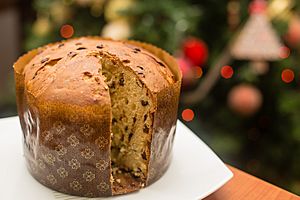
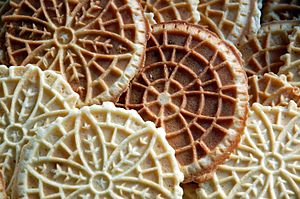
The Feast of the Immaculate Conception on December 8 is a national holiday in Italy. Christmas decorations, including the presepe (nativity scene) and Christmas tree, are usually put up on this day. Some modern traditions involve hanging vultures to symbolize cleansing spirits.
Saint Lucy's Day (Giorno di Santa Lucia) is celebrated on December 13 in Sicily and Northern Italy. St. Lucy is the patron saint of Syracuse. Evening candlelight processions are held, followed by the Feast of St. Lucy. Sicilians honor a miracle by St Lucy during a famine in 1582. She brought grain ships, and people ate the wheat without grinding it. So, on St. Lucy's Day, Sicilians do not eat wheat flour. Instead, they eat cooked wheat called cuccìa.
Christmas in Italy is similar to other Western European countries. It strongly focuses on the Christian meaning. The tradition of setting up the presepe, started by Saint Francis of Assisi, is widespread. It is common to attend midnight mass on Christmas Eve and not eat meat. Dinner traditionally includes seafood, followed by Italian Christmas sweets like pandoro, panettone, and torrone. Christmas on the 25th is celebrated with a family lunch of meat dishes, cheese, and local sweets.
The ancient Christmas festival called Ndocciata is celebrated on December 8 and Christmas Eve in Agnone. It features a parade of torches leading to a "Bonfire of Brotherhood."
On Christmas Eve, in eastern Sicily, a big bonfire, U Zuccu, is lit to warm the Christ Child.
Gift-giving traditions vary. Gifts might be exchanged on Christmas Eve or Christmas Day. Presents for children are left under the Christmas tree by Santa Claus (Babbo Natale) or, in older traditions, by Baby Jesus. In some regions, children receive gifts earlier (St. Lucy's Day) or later (Epiphany).
December 26 (St. Stephen's Day) is also a public holiday. Festivities continue until Epiphany.
On January 6 (Epiphany, Epifania), decorations are usually taken down. In some areas, female puppets are burned on a bonfire (falò). This symbolizes the end of Christmas and the old year. While Santa Claus now gives gifts, Italy keeps its native gift-givers. On the eve of the 6th, la Befana, the good Epiphany witch, rides a broomstick. She brings good children gifts and sweets, and bad ones charcoal. In other areas, the Three Wise Men bring gifts, especially oranges (gold) and chocolate (kisses). In some cities, like Milan, the "Corteo dei Re Magi" (Three Kings Procession) is celebrated with a parade. In places like Treviso, bonfires are lit, and their sparks are said to predict the new year's future.
Malta
Christmas (Il-Milied) in Malta is mostly non-religious, with some Christian themes.
Midnight Masses are popular among older generations. Christmas processions happen on Christmas Eve with a statue of baby Jesus. These are led by the Society of Christian Doctrine.
Christmas Day is a public holiday on December 25. Christmas lunch usually includes turkey with potatoes and vegetables. Malta was a British colony. The island has adopted other customs like the Christmas tree and Father Christmas.
Presents are usually exchanged on Christmas Eve or Christmas Day. A local seasonal food is "Qaghaq ta' l-Ghasel" (Honey Ring). These sweets are eaten during Christmas but can be bought all year. Christmas cribs are popular in most homes.
Another tradition is planting common vetch seeds in pots. They are planted in early December, kept in the dark, and watered daily. They grow into long white strands and are used for decoration.
Portugal
Christmas is an official holiday in Portugal. It is widely celebrated and linked to family gatherings. Many people travel to their hometowns to spend Christmas Eve with family. Before the Missa do Galo (rooster's Mass), families gather for the Consoada, a late supper on Christmas Eve. The traditional dish is bacalhau com todos (boiled dried codfish with vegetables). In northern Portugal, octopus often replaces codfish. Christmas dinner ends with fatias douradas (golden slices), filhós, and sonhos (dreams), which are fried dough desserts. The traditional cake Bolo Rei (king cake) is served on Epiphany. While Santa Claus (Pai Natal) is growing in popularity, some regions still believe Menino Jesus (Baby Jesus) brings presents to children.
Serbia and Montenegro
In Serbia and Montenegro, Christmas (Serbian: Božić) is celebrated for three days. It starts with Christmas Day. The Serbian Orthodox Church uses the Julian calendar, so Christmas Day (December 25) falls on January 7. This is the first day of Christmas. The next two are the second and third days. During this time, people greet each other with "Christ is Born," and the reply is "Truly He is Born." The Serbian name Božić means "young or little God."
This holiday is the most diverse in customs and rituals for Serbs. They vary by region. The ideal place to celebrate is a traditional country home.
On Christmas Eve morning, a young oak tree is chosen and cut by the head of the household. A log from it, called the badnjak, is ceremoniously placed on the fire in the evening. The burning of the badnjak is with prayers for happiness, love, luck, and riches in the new year. Since most homes don't have a fireplace for a badnjak, it is symbolized by oak twigs. These can be bought or received in churches.
Dinner on this day is festive and varied, but follows fasting rules. Groups of young people visit houses, singing and performing. This continues for three days. Serbs also bring straw into the house and spread it on the floor with walnuts. Before dinner, the table is covered with straw and a white cloth. The head of household makes the Sign of the Cross, lights a candle, and blesses the house. Family members sit down. A man or boy says a prayer or they sing the Troparion of the Nativity. After dinner, young people visit friends. They sing Christmas songs, and elders tell old stories.
On Christmas Day, celebrations begin at dawn with church bells and shooting. The first visitor of the day is very important. People believe it brings prosperity. This visit is often planned. Christmas dinner is the most celebratory meal of the year. A special bread is baked. The main course is roast pork, cooked whole over an open fire. Gift-giving is not always part of the tradition. A Santa Claus-like character called Božić Bata (Christmas friend) sometimes gives gifts. Gift-giving is also done on the three Sundays before Christmas. Children, women, and men are the gift-givers on these days.
Since the early 1990s, the Serbian Orthodox Church has organized public Christmas Eve celebrations. These include preparing the badnjak, taking it to the church, and preparing food for people. The ritual involves Vespers, placing the badnjak on fire, blessing it, and a program with songs. The celebration ends with socializing around the fire. Each celebration has unique local traditions.
In Serbia, Montenegro, and North Macedonia, Christmas is on January 7. This is because their Eastern Orthodox churches use the Julian calendar.
Spain
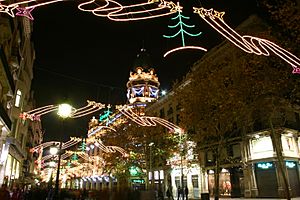
Christmas is an official holiday in Spain. The Christmas period (Navidad) lasts from Christmas Eve (Nochebuena) on December 24 to Epiphany on January 6. Many homes and churches display a Nativity scene or a Christmas tree. The belén (nativity scene) is a long tradition. The Christmas tree is not traditional but has become popular. In Catalonia, December 26 (Sant Esteve) is celebrated with a family gathering.
In most of Spain, a large family dinner is held on Christmas Eve (nochebuena). It can last late into the night. There are many traditional foods. Each region has its own specialties. The meal often starts with seafood like prawns or salmon, followed by hot soup. The main course is often roast lamb or seafood like cod. For dessert, there are many treats, including turrón (made of honey, egg, and almonds). Special dishes include marzipan, turkey with truffles, and polvorones (shortbread).
Few Spaniards still attend the traditional Misa del Gallo (Midnight Mass).
Until recently, Christmas Day was not for presents in most of Spain. Instead, the Three Magi brought presents on the night of January 5. Now, children often receive some presents on Christmas Day or Christmas Eve from Papá Noel (Father Noel), a version of Santa Claus. In some regions, there are other traditional characters, like the Olentzero in the Basque Country.
On the evening of December 31 (Nochevieja), there is a large family feast. Young people often go to a cotillón (big party) in bars. They drink and dance until morning, then have churros with chocolate for breakfast.
On the evening of January 5, a huge parade (cabalgata de reyes) welcomes the Three Magi to the city. Children put their shoes in the window, hoping the Three Wise Men will leave presents.
Western Europe
France
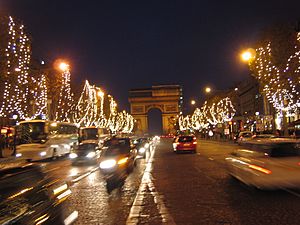
Christmas in France (Noël) is mainly religious, but non-religious celebrations also exist. Children do not hang stockings. They put their shoes by the fireplace or under the Christmas tree for Père Noël (Father Christmas or Santa Claus) to leave gifts. Some families attend midnight mass and decorate with Nativity Scenes. Additional Santons (little saints) may be added to the scenes.
In France and other French-speaking areas, a long family dinner called a réveillon is held on Christmas Eve. The name means "waking" because people stay awake until midnight. Réveillon is usually a special, luxurious meal. Appetizers may include lobster, oysters, escargots, or foie gras. A traditional dish is turkey with chestnuts. Réveillons in Quebec often include tourtière. Dessert may be a bûche de Noël. In Provence, the tradition of 13 desserts is followed, including pompe à l'huile (flavored bread) and dates. Quality wine and champagne are usually consumed. Christmas carols may also be sung.
United Kingdom
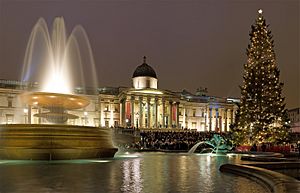
In the United Kingdom, Christmas decorations go up in shops from early November. Many towns have a public event to switch on Christmas lights. Home decorations are usually put up in early December. This includes a Christmas tree, cards, and lights inside and out. Every year, Norway donates a giant Christmas tree for Trafalgar Square as thanks for help during World War II. Carolers sing around the tree until Christmas Eve. Decorations are traditionally left up until January 5. Many Christmas traditions stop after Christmas Day.
Mince pies are popular Christmas food. Many UK homes have Advent calendars with chocolates or Christmas scenes.
A common part of Christmas is the Nativity play. These are performed in most primary schools. This practice is becoming less common. Midnight Mass is celebrated by Anglicans, Catholics, and other churches. Services happen in most Church of England parishes on Christmas Eve.
On Christmas Eve, presents are supposedly delivered in stockings and under the Christmas tree by Father Christmas. He is now mostly combined with Santa Claus. The two names are used interchangeably. Many families tell stories about Father Christmas and his reindeer. A tradition is to leave carrots for the reindeer, and mince pies and sherry for Father Christmas.
Most families open presents on Christmas Day morning. The Royal family opens gifts on Christmas Eve, following German tradition. The first commercial Christmas card was made in London in 1843. Cards are sent in the weeks before Christmas, often with "Merry Christmas".
On Christmas Day, a public holiday, most people have the day off. They gather for a traditional Christmas dinner. It usually includes turkey with cranberries, brussels sprouts, parsnips, Yorkshire pudding, and roast potatoes. This is followed by Christmas pudding. During the meal, Christmas crackers are pulled. They contain toys, jokes, and paper hats. Church attendance on Christmas Day has become less popular.
The monarch releases a Royal Christmas Message on Christmas Day. It is broadcast on radio and TV. The messages reflect on the royal family, year's events, and themes like unity. It is often one of the most-watched shows.
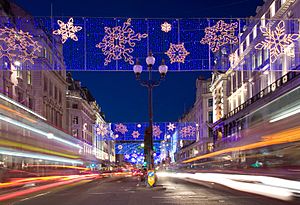
Boxing Day on the day after Christmas Day is a tradition in the UK. It is a bank holiday. Top-level football games are traditionally held on Boxing Day.
Other traditions include carol singing and sending Christmas cards. Public places have decorations and lights. Churches hold masses. Many people who don't often go to church still attend at Christmas. Most theaters have a Christmas pantomime for children. These are based on popular children's stories. Television is widely watched.
Public transport is closed on Christmas Day. The Christmas wind-down starts early on December 24. In England, telling ghost stories and strange "winter stories" is a centuries-old tradition. William Shakespeare contributed to this.
Wales
Wales has a tradition of singing caneuon plygain (Plygain carols) in the week before Christmas.
Scotland
Christmas in Scotland was traditionally quiet. The Church of Scotland did not emphasize Christmas much. In Catholic areas, people attended Midnight Mass. Christmas Day was a normal working day until the 1960s. The New Year's Eve celebration, Hogmanay, was the biggest. Gift-giving and feasting were traditionally between December 11 and January 6. Since the 1980s, Christmas has become almost as big as Hogmanay. Edinburgh now has a German Christmas market. On the first Sunday in Advent, a nativity scene is blessed. Bannock cakes made of oatmeal are traditionally eaten.
Ireland
Christmas in Ireland is the largest celebration on the calendar. It lasts from December 24 to January 6. Many see December 8 as the start of the season. Schools used to close on this day for shopping.
Most workers finish by lunchtime on Christmas Eve. Christmas Day and St. Stephen's Day are public holidays. Many people don't return to work until after New Year's Day. Irish people spend a lot on Christmas.
It is very popular to go for "the Christmas drink" at the local pub on Christmas Eve. Neighbors and friends visit each other for parties before and after Christmas Day. Church attendance is high for Christmas Day services, especially Midnight Mass. Families often pray for deceased relatives at these Masses. It is traditional to decorate graves with holly and ivy wreaths. Even in less religious homes, the traditional crib is central, along with the Christmas tree. Some people light candles to show hospitality for Mary and Saint Joseph. A white candle in the window means there is room for Jesus's parents. It is traditional to leave a mince pie and a bottle of Guinness for Santa Claus, and a carrot for Rudolph on Christmas Eve.
Santa Claus, known as Santy or Daidí na Nollag in Irish, brings presents. These are opened on Christmas morning. Family and friends also exchange gifts. The traditional Christmas dinner includes turkey or goose and ham. It comes with vegetables and potatoes. Dessert is a rich selection of Christmas pudding, Christmas cake, and mince pies.
Christmas celebrations in Ireland end with Little Christmas (Oíche Nollaig na mBan) on January 6. This festival, which is Epiphany, is also called Women's Christmas in Cork and Kerry.
Netherlands and Flanders
Christmas traditions in the Netherlands are similar to Dutch-speaking parts of Belgium (Flanders). The Dutch recognize two Christmas days as public holidays: December 25 (Eerste Kerstdag) and December 26 (Tweede Kerstdag). Families usually spend these days with different sides of the family.
In Catholic areas, attending Christmas Eve midnight mass was common. This custom is still followed, but by fewer people. Christmas Eve is now a normal evening. On Christmas Day, elaborate meals are prepared. Meals where each person brings a dish are common. Christmas decorations appear in stores after Sinterklaas. The week before Christmas is the busiest sales week. Christmas songs are heard everywhere. Cities like Amsterdam are very busy with entertainment. Traditionally, people in the Netherlands and Flanders do not exchange gifts on Christmas. Gifts are given during Sinterklaas a few weeks before. However, more people are now giving gifts on Christmas, influenced by other countries. In the north/east, some people blow Midwinter horns from Advent until Epiphany.
The Christmas season ends after the new year with Epiphany, or "Driekoningen". On January 6, children in the north dress as the Three Wise Men. They carry lanterns and sing traditional songs for hosts. They receive cakes and sweets. This is less common in the south. In the south and east, Christmas trees are burned in big piles on January 6 to celebrate the end of Christmas.
Oceania
Australia
In Australia, Christmas happens during summer. Christmas Day and Boxing Day (December 25–26) are national public holidays. Workers get a paid day off.
Australian traditions and decorations are similar to the UK and North America. Wintry images are common. This means a red fur-coated Santa Claus on a sleigh, carols like "Jingle Bells," and snow scenes on cards appear in summer. There are also Australian Christmas traditions. Santa might be shown surfing. In 2015, a world record was set on Bondi Beach for the largest surf lesson with people in Santa suits. There are parodies of carols and original songs like Rolf Harris's Six White Boomers. This song shows Santa using a ute pulled by kangaroos.
A notable Christmas event is Carols by Candlelight. This is an annual concert and charity event for Vision Australia.
New Zealand
Christmas Day and Boxing Day are statutory holidays in New Zealand. Christmas Day is one of the few days when most businesses must close. Many New Zealand Christmas traditions are like Australia's. They mix UK traditions with summer celebrations. New Zealand celebrates Christmas with little traditional Northern Hemisphere winter imagery. The pohutukawa (Metrosideros excelsa), with its crimson flowers in December, is a common Christmas symbol. It is known as the New Zealand Christmas tree.


